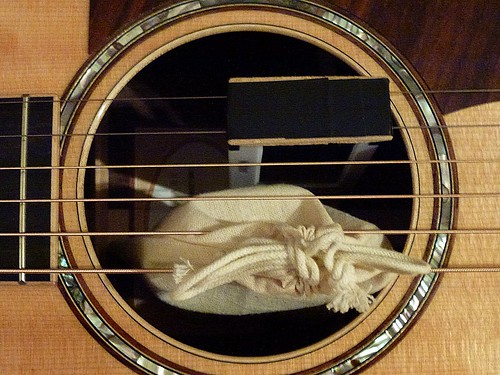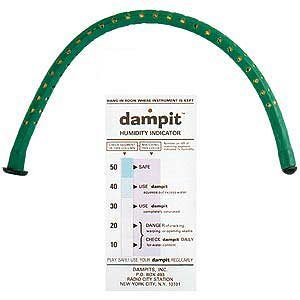
 |
|
#16
|
|||
|
|||
|
Quote:
One thing I have noticed since I've been using the remote sensors is that the temp and rH in the cases changes much more slowly than the environment in the house does. The case really moderates the changes.
__________________
1995 Taylor 412 1995 Taylor 612C Custom, Spruce over Flamed Maple 1997 Taylor 710 1968 Aria 6815 12 String, bought new |
|
#17
|
|||
|
|||
|
Quote:
So I put silica gel in cotton bags, AND the hygrometer, supported by the strings, inside the soundhole, as I've described here: In-case dehumidification The result looks like this: 
__________________
Last edited by N+1; 07-21-2018 at 01:55 AM. |
|
#18
|
||||
|
||||
|
Quote:
I humidify the room, and just keep the hygrometer in the room the guitar cases live in, because they will be the same level of humidified as the room before long. Of course if you are adding additional humidifiers in the case, then sure, put a hygrometer in the case too, and in the pick compartment is fine (I prop the lid a hair using either a thumb pick or old Snark clip after it breaks). I have 7 guitars so it's easier to humidify the room. |
|
#19
|
|||
|
|||
|
Thanks Larry- unfortunately I don't have a dedicated room for my gear. Theyre kinda spread out over the house.
|
|
#20
|
||||
|
||||
|
No, I would say you need the hygrometer in the main compartment of the case to get a reasonably accurate response if you are relying on controlling only the in-case RH.
I use Caliber IV hygrometers that are maybe a bit slimmer than yours, and these sit easily either in the cut-away area or anywhere there is a small gap. If not I would do as N+1 recommends (I also use small cotton bags with S Gel in between the strings). |
|
#21
|
|||
|
|||
|
I use the Taylor models. Big one in guitar room and small one in case's pick compartment. I have found these to be very accurate and they accurately change immediately with humidity changes (its cool to watch) I also do not see any difference in location i place it in the case so it stays in gear/pick compartment and works great!
__________________
Guitar Fundi Gibson "Custom Late 1950's Reissue Southern Jumbo Triburst" Taylor 314CE (Built by Ren Ferguson) Mystery Resonator Fender Stratocaster |
|
#22
|
|||
|
|||
|
Quote:
Thanks for keeping me honest  I should have been clearer, but I was talking about the main section of the case.
__________________
1995 Taylor 412 1995 Taylor 612C Custom, Spruce over Flamed Maple 1997 Taylor 710 1968 Aria 6815 12 String, bought new |
|
#23
|
|||
|
|||
|
It seems that a case is not just a case: from the comments of others here, I conclude that different cases allow different degrees of air movement.
Most of my guitars are Taylors, in Taylor hard cases. I've tested various combinations of gel pack and hygrometer placing quite thoroughly, and in my Taylor cases the headstock area and the tool compartment are very effectively isolated from the main body of the case. Gel packs placed up there have almost no effect on the relative humidity in the main part of the case (which is what primarily needs to be controlled to keep the body of the guitar happy). My point is: you'd be wise to test out your particular case or cases, and don't assume free air movement throughout the various compartments. I'm in no doubt that in my situation, the optimum placing for both gel beads AND hygrometer is inside the guitar's soundhole.
__________________
|
|
#24
|
|||
|
|||
|
Double-posted by mistake. Apologies.
__________________
Last edited by N+1; 07-21-2018 at 03:47 PM. |
|
#25
|
|||
|
|||
|
Quote:
As they are so cheap, I have a few scattered around the house too.
__________________
Silly Moustache, Just an old Limey acoustic guitarist, Dobrolist, mandolier and singer. I'm here to try to help and advise and I offer one to one lessons/meetings/mentoring via Zoom! |
|
#26
|
||||
|
||||
|
Quote:
Given that the goal is to keep the humidity at safe levels for the guitar, and not museum quality humidity control, anywhere in the case is good enough. Whether you put it in the pick drawer and prop it open a bit, or put it in the body section, if you are humidifying the guitar, that's what counts. The old Dampit humidifiers (and the new ones still sold today) just had a card in them that gave general indicators, and it was all we really needed.  I'm old (70 yrs old this year) and back in the mid-1900s guys used to cut half an apple and toss it into the pick drawer to humidify (don't recommend it). When it dried out, they replaced it. We've come a long ways now - I use sponges in a ziplock bag with slits cut into it. |
|
#27
|
|||
|
|||
|
Thanks for your feedback on this regarding your experiments. I kind of figured there is not a lot of "air flow communication" between the body and neck compartments in my case. Thus my neck compartment hygrometer isn't really telling me anything about the humidity level in my body. I have tried finding a hygrometer that is small enough to fit in the body compartment but haven't found one. Maybe I have to get a new, slightly larger case?
__________________
Martin D-28 Taylor 814 CE |
|
#28
|
|||
|
|||
|
Quote:
Quote:
 Post #17 above shows it in situ, alongside a bag of gel beads. (The hygrometer is placed with the sensor side pointing away from the gel bag.)
__________________
Last edited by N+1; 07-21-2018 at 03:22 PM. |
|
#29
|
|||
|
|||
|
Quote:
Warren
__________________
Martin D-28 Taylor 814 CE |
|
#30
|
|||
|
|||
|
Quote:
And yes, a lot cheaper than a new case. Good luck!
__________________
|